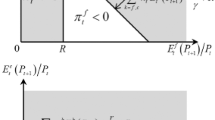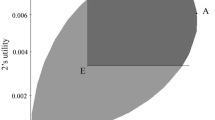Abstract
This paper investigates the impact of market incompleteness on investment decisions. In contrast to previous studies, we assume an entrepreneur has power utility and investment causes an additive increase in her wealth. By using the binomial theorem, we derive the analytical solutions for the option value and investment threshold. First, we show that an increase in wealth alleviates the over-investment problem caused by the market incompleteness. In addition, the marginal value of wealth is always more than one and decreases in the wealth level. Finally, the increase in wealth substantially enhances the value of the investment option and lowers the idiosyncratic risk premium.







Similar content being viewed by others
Notes
Majd and Pindyck (1987) extend the basic model with a time-to-build feature. Dixit (1989) considers entry and exit decisions under uncertainty. Dixit and Pindyck (1994) provide a textbook treatment of important contributions to this literature. Grenadier (1996), Grenadier (2002), Grenadier and Malenko (2011) and Bensoussan et al. (2017) consider the real options problem in a game-theoretic environment.
For example, consider entrepreneurial activities. Entrepreneurs might have valuable projects, but these projects might not be freely traded or their payoffs might not be spanned by existing assets. These capital market imperfections could be due to agency frictions or transactions costs. Thus, investment opportunities can have substantial non-diversifiable idiosyncratic risks. Moreover, entrepreneurs’ well-being depends heavily on the outcome of their investments. As documented by Moskowitz and Vissing-Jorgensen (2002), about 3/4 of all private equity is owned by households for whom it constitutes at least half of their total net worth.
Besides the preference-based approach, Thijssen (2011) interprets market incompleteness as a source of ambiguity over the appropriate no-arbitrage discount factor.
An exception is Choi et al. (2017). In their paper, exercising the option results in a proportional increase in the entrepreneur’s wealth. However, they make such an assumption just for the tractability consideration as well.
We take the discounting factor inside the utility function, while it is common to have it separately out of the utility function. Consider the case with zero project value, then the choice of \(\tau\) should have no influence on the entrepreneur’s value function. If the discounting factor stays outside the utility function, the entrepreneur’s value will be affected by \(\tau\), which is undesirable.
There are several reasons why we work with certainty equivalent wealth P(W, X) rather than directly with the value function J(W, X). First, certainty equivalent wealth is an intuitive concept and is measured in units of wealth, while the unit for value function J(W, X) is utils, which cannot be directly measured. Second, P(W, X) is analytically convenient to work with. Third, the marginal (certainty equivalent) value of wealth, \(P_W(W,X)\) is a natural measure for the impact of financial frictions.
Of course, other parameters like risk aversion and discount rate also affect the investment decision. However, we only focus on the effect of wealth in describing our implications since it it the focus of this paper.
References
Alpanda S, Woglom G (2007) The case against power utility and a suggested alternative: resurrecting exponential utility. Working paper
Bensoussan A, Hoe S, Yan Z, Yin G (2017) Real options with competition and regime switching. Math Finance 27:224–250
Black F, Scholes M (1973) The pricing of options and corporate liabilities. J Political Econ 81:637–659
Bolton P, Chen H, Wang N (2011) A unified theory of Tobin’s \(q\), corporate investment, financing, and risk management. J Finance 66:1545–1578
Bolton P, Chen H, Wang N (2013) Market timing, investment, and risk management. J Financ Econ 109:40–62
Bolton P, Wang N, Yang J (2019a) Liquidity and risk management: coordinating investment and compensation policies. J Finance 74:1363–1429
Bolton P, Wang N, Yang J (2019b) Investment under uncertainty with financial constraints. J Econ Theory 184:104912
Chen H, Miao J, Wang N (2010) Entrepreneurial finance and non-diversifiable risk. Rev Financ Stud 23:4348–4388
Choi K, Kwak M, Shim G (2017) Time preference and real investment. J Econ Dyn Control 83:18–33
Ciochetti B, Timothy C, James S (2000) Characteristics of institutional investment in real estate trusts. Working paper, University of Wisconsin-Madison
Cressy R (2000) Credit rationing or entrepreneurial risk aversion? An alternative explanation for the Evans and Jovanovic finding. Econ Lett 66:235–240
DeMarzo P, Fishman M, He Z, Wang N (2012) Dynamic agency and the \(q\) theory of investment. J Finance 67:2295–2340
DeMarzo P, Sannikov Y (2006) Optimal security design and dynamic capital structure in a continuous-time agency model. J Finance 61:2681–2724
Dixit A (1989) Entry and exit decisions under uncertainty. J Political Econ 97:620–638
Dixit A, Pindyck R (1994) Investment under uncertainty. Princeton University Press, Princeton
Gose J (2001) Investors prefer urban office space to suburban (again). Barron’s April 4, 53
Grenadier S (1996) The strategic exercise of options: development cascades and overbuilding in real estate markets. J Finance 51:1653–1679
Grenadier S (2002) Option exercise games: an application to the equilibrium investment strategies of firms. Rev Financ Stud 15:691–721
Grenadier S, Malenko A (2011) Real options signaling games with applications to corporate finance. Rev Financ Stud 24:3993–4036
Grenadier S, Wang N (2007) Investment under uncertainty and time-inconsistent preferences. J Financ Econ 84:2–39
Hayashi F (1982) Tobin’s marginal \(q\) and average \(q\): a neoclassical interpretation. Econometrica 50:213–224
Henderson V (2007) Valuing the option to invest in an incomplete market. Math Financ Econ 1:103–128
Hugonnier J, Morellec E (2007) Corporate control and real investment in incomplete markets. J Econ Dyn Control 31:1781–1800
Majd S, Pindyck R (1987) Time to build, option value, and investment decision. J Financ Econ 18:7–28
McDonald R, Siegel D (1986) The value of waiting to invest. Q J Econ 101:707–727
Mehra R, Prescott EC (1985) The equity premium puzzle: a puzzle. J Monet Econ 15:145–161
Merton RC (1969) Lifetime portfolio selection under uncertainty: the continuous-time case. Rev Econ Stat 51:247–257
Merton RC (1992) Continuous time finance. Blackwell Publishing Co, Cambridge
Miao J, Wang N (2007) Investment, consumption, and hedging under incomplete markets. J Financ Econ 86:608–642
Moskowitz TJ, Vissing-Jorgensen A (2002) The returns to entrepreneurial investment: A private equity premium puzzle? Am Econ Rev 92:745–778
Sorensen M, Wang N, Yang J (2014) Valuing private equity. Rev Financ Stud 27:1977–2021
Thijssen JJ (2011) Incomplete markets, ambiguity, and irreversible investment. J Econ Dyn Control 35:909–921
Wang C, Wang N, Yang J (2016) Optimal consumption and savings with stochastic income and recursive utility. J Econ Theory 165:292–331
Funding
Jinqiang Yang acknowledges the support of the National Natural Science Foundation of China (#71772112) and Innovative Research Team of Shanghai University of Finance and Economics (#2016110241). Zhentao Zou acknowledges the support of the National Natural Science Foundation of China (#72003142) and Fundamental Research Funds for the Central Universities (#413000172, #413000276).
Author information
Authors and Affiliations
Corresponding author
Additional information
Publisher’s Note
Springer Nature remains neutral with regard to jurisdictional claims in published maps and institutional affiliations.
Appendices
Appendix A: Proof of Proposition 1
First, we find that it is difficult to directly derive the solution of \(P\left( W,X\right)\) from the PDE (16). However, we can rewrite (5) as
Here, we use the binomial theorem. Since \(W_{t}\) is known at time t, we have
Then, we treat \(V_{n,t}=\) \(\mathbb {E}_{t}\left\{ e^{-nr\left( \tau -t\right) }\left( X_{\tau }-I\right) ^{n}\right\}\) as the value of a conjectured real option with discount rate nr and lump-sum payoff \(\left( X_{\tau }-I\right) ^{n}\). Based on the standard arguments, \(V_{n}\) satisfies the following ODE:
Combining this with boundary condition \(V_{n}\left( \overline{X}\right) =\left( \overline{X}-I\right) ^{n}\), we have
where
Therefore, we obtain the closed-form solution for \(P\left( W,X\right)\) as
First, we can easily verify that the above solution satisfies boundary conditions (17), (18) and (20). From boundary condition ( 19), we obtain the optimal investment threshold as
To guarantee convergence for the left-hand side of the above equation, we need \(W>\overline{X}-I\).
For the special cases of \(\gamma =1\) and \(\gamma =2\), the solutions for the entrepreneur’s certainty equivalent wealth and the investment threshold can be further simplified.
Special case I: \(\gamma =1\)
When the entrepreneur has log utility, her certainty equivalent wealth \(P\left( W,X\right)\) becomes
where \(V_{n}\left( X\right)\) is given by (22). The optimal investment threshold \(\overline{X}\left( W\right)\) becomes the solution of the following equation
Special case II: \(\gamma =2\)
When the entrepreneur’s risk aversion coefficient equals 2, her certainty equivalent wealth \(P\left( W,X\right)\) becomes
and the optimal investment threshold \(\overline{X}\left( W\right)\) becomes the solution of the following equation:
B Proof of Proposition 2
Following Wang, Wang and Yang (2016), we complete markets by introducing a tradable asset that is perfectly correlated with the project value. Since the project risk is idiosyncratic, it can be diversified away at no premium. Hence, the dynamics of this new financial asset are given by
where \(\sigma _{S}\) is the volatility parameter and Z is the same Brownian motion driving the dynamics of project value. When the market is incomplete, there is no such a tradable asset that is perfectly correlated with the project value. Hence this variable S disappears in the incomplete market case. Denote \(\phi _{t}\) as the fraction of the agent’s wealth in this asset; then, the entrepreneur’s wealth W evolves as follows:
Using the standard principle of optimality, the value function satisfies the following PDE:
Compared with (12), there exist two additional terms on the right-hand side of the PDE: \(\frac{1}{2}\phi ^{2}\sigma _{S}^{2}W^{2}J_{WW}\) and \(\phi _{t}\sigma _{S}\sigma WXJ_{WX}\). We have \(J_{WW}\) and \(J_{WX}\) due to the stochastic returns for the new risky asset and dynamic hedging, respectively.
Similarly, we write the value function as
Then, we have
The FOC for hedging demand \(\phi\) implies
Substituting the optimal hedging demand into the PDE (B.5), we obtain
By using the insights for the CM case, we conjecture
Substituting the above-conjectured solution into (B.7) and the four boundary conditions (17) to (20), we have
Therefore, (B.8) is indeed the solution for the CM model. Substituting the solution into (B.6) yields the following optimal hedging portfolio:
Then, we obtain the wealth dynamics \(W_{t}\):
Thus, the entrepreneur’s wealth is negatively correlated with the project value. For the total wealth \(P^{*}\left( W,X\right)\), we have
which means that the total wealth is deterministic and increases at rate r.
Appendix C: Proof of Proposition 3
When the project has value \(X_{t}\) follows a arithmetic Brownian motion, the ODE for \(V_{n}\) is replaced by
Combining this with boundary condition \(V_{n}\left( \overline{X}\right) =\left( \overline{X}-I\right) ^{n}\), we have
where
Therefore, we obtain the closed-form solution for \(P\left( W,X\right)\) as
Then we obtain the optimal investment threshold as
To guarantee convergence for the left-hand side of the above equation, we need \(W>\overline{X}-I\) as well.
When the market is complete, the optimal investment threshold \(X^{*}\) is standard as
where
Rights and permissions
About this article
Cite this article
Niu, Y., Yang, J. & Zou, Z. Investment decisions under incomplete markets in the presence of wealth effects. J Econ 133, 167–189 (2021). https://doi.org/10.1007/s00712-021-00731-1
Received:
Accepted:
Published:
Issue Date:
DOI: https://doi.org/10.1007/s00712-021-00731-1




